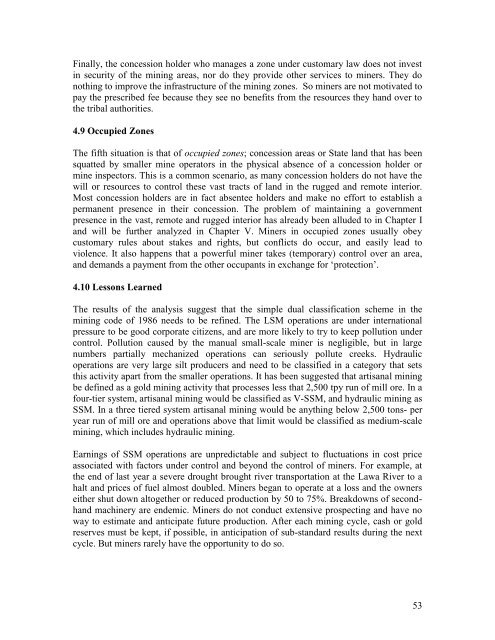SITUATION ANALYSIS OF THE SMALL-SCALE GOLD ... - WWF
SITUATION ANALYSIS OF THE SMALL-SCALE GOLD ... - WWF
SITUATION ANALYSIS OF THE SMALL-SCALE GOLD ... - WWF
You also want an ePaper? Increase the reach of your titles
YUMPU automatically turns print PDFs into web optimized ePapers that Google loves.
Finally, the concession holder who manages a zone under customary law does not invest<br />
in security of the mining areas, nor do they provide other services to miners. They do<br />
nothing to improve the infrastructure of the mining zones. So miners are not motivated to<br />
pay the prescribed fee because they see no benefits from the resources they hand over to<br />
the tribal authorities.<br />
4.9 Occupied Zones<br />
The fifth situation is that of occupied zones; concession areas or State land that has been<br />
squatted by smaller mine operators in the physical absence of a concession holder or<br />
mine inspectors. This is a common scenario, as many concession holders do not have the<br />
will or resources to control these vast tracts of land in the rugged and remote interior.<br />
Most concession holders are in fact absentee holders and make no effort to establish a<br />
permanent presence in their concession. The problem of maintaining a government<br />
presence in the vast, remote and rugged interior has already been alluded to in Chapter I<br />
and will be further analyzed in Chapter V. Miners in occupied zones usually obey<br />
customary rules about stakes and rights, but conflicts do occur, and easily lead to<br />
violence. It also happens that a powerful miner takes (temporary) control over an area,<br />
and demands a payment from the other occupants in exchange for „protection‟.<br />
4.10 Lessons Learned<br />
The results of the analysis suggest that the simple dual classification scheme in the<br />
mining code of 1986 needs to be refined. The LSM operations are under international<br />
pressure to be good corporate citizens, and are more likely to try to keep pollution under<br />
control. Pollution caused by the manual small-scale miner is negligible, but in large<br />
numbers partially mechanized operations can seriously pollute creeks. Hydraulic<br />
operations are very large silt producers and need to be classified in a category that sets<br />
this activity apart from the smaller operations. It has been suggested that artisanal mining<br />
be defined as a gold mining activity that processes less that 2,500 tpy run of mill ore. In a<br />
four-tier system, artisanal mining would be classified as V-SSM, and hydraulic mining as<br />
SSM. In a three tiered system artisanal mining would be anything below 2,500 tons- per<br />
year run of mill ore and operations above that limit would be classified as medium-scale<br />
mining, which includes hydraulic mining.<br />
Earnings of SSM operations are unpredictable and subject to fluctuations in cost price<br />
associated with factors under control and beyond the control of miners. For example, at<br />
the end of last year a severe drought brought river transportation at the Lawa River to a<br />
halt and prices of fuel almost doubled. Miners began to operate at a loss and the owners<br />
either shut down altogether or reduced production by 50 to 75%. Breakdowns of secondhand<br />
machinery are endemic. Miners do not conduct extensive prospecting and have no<br />
way to estimate and anticipate future production. After each mining cycle, cash or gold<br />
reserves must be kept, if possible, in anticipation of sub-standard results during the next<br />
cycle. But miners rarely have the opportunity to do so.<br />
53
















